Contents
Savory is an annual plant that has been used as a spice for a long time. As early as the ninth century, monks brought it to Central Europe. The delicate aroma of the herb and its pleasant taste have made savory popular and widely used.
The properties of the plant are used not only in cooking as a spice, but also in folk medicine, since the healing properties of this spice have been proven. It is worth knowing what a plant looks like, where it grows and how it is used in order to avoid mistakes in growing and using.
What is this herb “savory”
As you can see in the photo, savory is a grass, with a highly branched stem with a lot of leaves and purple flowers. It is distinguished by spicy properties, strong aroma, pungency with a bitter aftertaste.
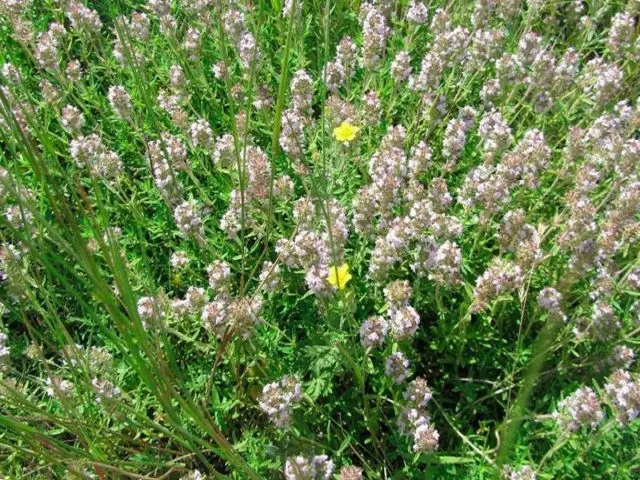
In American and European cooking, this versatile seasoning is used to improve the taste of soups, meat and vegetable dishes. Savory is native to the Mediterranean. There are about 30 types of plants, but garden and mountain are most often used in cooking.
What does savory look like
Spicy herb belongs to the Lamiaceae family. The leaves of the plant are entire, with short petioles. The flowers are bluish, pinkish or light purple. They are found in the axils of the leaves. Their calyx is correct, bell-shaped, the corolla is two-lipped. The flower has four stamens, its stigma has diverging lobes.
The fruits are nuts, the shape of which can be round or ovoid.
Garden savory reaches a height of 70 cm, has a strongly branched stem, purple flowers. The grass has other names besides the garden one – chobr, sheber, fragrant, summer, satureya hortensis.
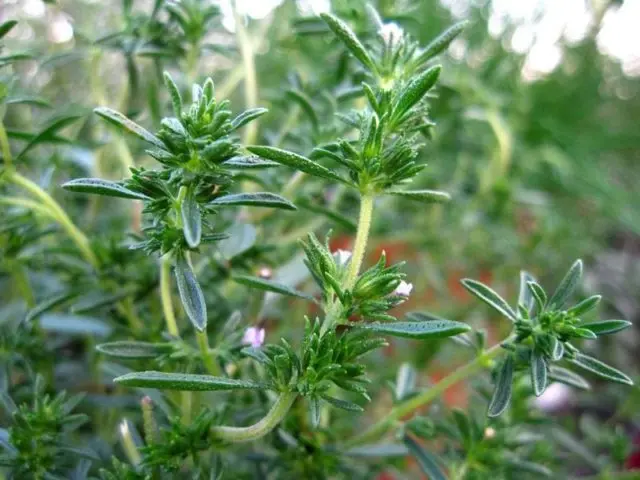
The mountain view grows up to 60 cm, has pubescent stems, flowers are white-pink, 1 cm in diameter. The culture has creeping and erect forms.
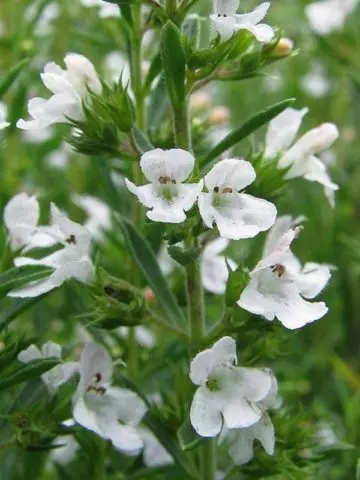
Mountain savory, unlike garden savory, has a more burning taste, it is required much less for dishes, since it has a stronger smell.
After drying, the spice has a strong aroma, but after a year it disappears. The best ways to store the herb are to soak it in oil or freeze it.
What is another name for savory
Aromatic spice is widely used in the national cuisines of the world. It is difficult to imagine some dishes of the Balkan countries without savory. In Bulgaria, it is called chubrica, which is put in soups, added to meat and fish dishes. In Georgia, this is kandari. Kharcho, chanakhi greatly benefit from the addition of spices. The Moldavian name of the seasoning is chimbru, the Armenian name is citron, and the Uzbek name is jambul.
Where grows
According to the description, savory prefers sandy or loamy loose, drained soils. On soils with a neutral pH, it can produce an increased amount of green matter with a brighter and richer taste. Grass spreads well on rocky slopes, on rocks.
The plant is cultivated as a garden plant, but often it runs wild and then spreads as a weed.
The savory plant (photo) is unpretentious in cultivation and care, undemanding to the temperature regime and soils.
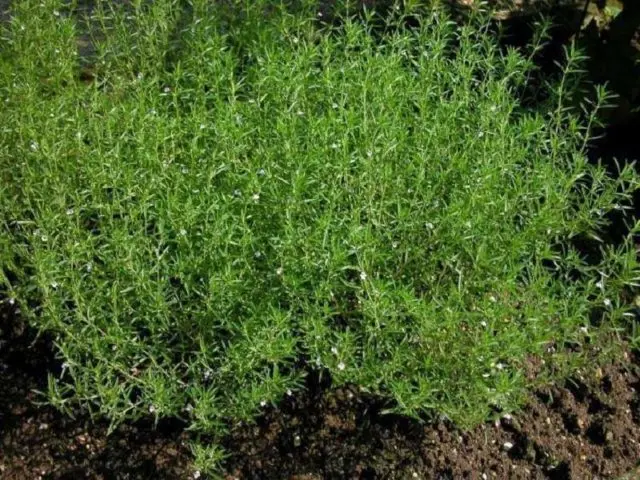
In the conditions of the Moscow region, the sowing of spicy grass is carried out at the end of April in a greenhouse. After the soil has completely warmed up, the seedlings are planted in open ground. The landing site should be spacious, well lit, cleared of weeds. The location in the shade of garden trees is not suitable for savory. The grass is decorative, so it can be used in landscape design.
Harvesting of raw materials is carried out immediately after the start of flowering.
The spice can be grown at home, as a pot culture, on a windowsill or balcony. After cutting the shoots on the bushes, new, young ones soon grow.
Under natural conditions, spicy grass can be found in Central Asia, Turkey, in the south of Europe, in the Crimea.
The benefits and harms of savory for the body
The medicinal properties of this spice have been known since ancient times. In Germany and France, the garden species is officially recognized as a medicinal plant and is used as an antibacterial agent.
The benefits of savory for the body are in a number of properties:
- antiseptic;
- antioxidant;
- mucolytic;
- wind turbine;
- stimulating digestion.
Spicy herb is used in different forms: in the form of tea, infusion, inhalation, rinsing, dry matter and essential oil.
Useful properties of garden savory are used for many pathologies:
- stomach colic;
- infectious diarrhea;
- bronchitis
- tracheitis;
- laryngitis;
- with type 2 diabetes;
- stomatitis and gingivitis;
- baldness and dandruff;
- with itchy skin from insect bites.

In addition to medicinal properties, savory herb also has contraindications for use. You can not use it for stomach and duodenal ulcers, atrial fibrillation, thyroid pathologies, cardiosclerosis, allergic reactions. Savory-based preparations during pregnancy are strictly prohibited, as they can cause uterine contractions and lead to miscarriage.
The mountain view contains an essential oil, the main component of which is carvacrol. There are a lot of vitamins, phytoncides, minerals in greens. The healing properties of mountain savory are used in folk medicine for colitis, vomiting, enteritis, and digestive problems. Spicy grass also has a diaphoretic, diuretic, astringent effect on the body. Contraindications to the use of mountain savory apply to those who have individual intolerance and allergies to the product.
The use of savory in folk medicine
Various medicinal forms are prepared from the spicy plant.
Decoction of helminths
To prepare a decoction, dried grass (30 g) is poured into 300 g of boiling water, insisted and drunk at night. The taste of savory is bitter. The tool helps with infection with helminths.
Dry cough tea
To prepare cough tea, you need to pour 15 g of dry savory herb with a glass of boiling water and insist in a water bath. Take a sip every 15 minutes. May be used with honey to enhance the effect.
Infusion for hypertension
Two tablespoons of dry grass must be poured with 500 mg of boiling water and insisted for about an hour. After filtration, the agent is used 100 g four times a day for the initial form of hypertension.
Therapeutic baths for asthma and skin diseases
Infuse 100 g of dry herb in a liter of boiling water for 30 minutes, strain and pour into a bath of warm water. Take a bath for about 30 minutes.
inhalation
Essential oil from savory is used for inhalation using a nebulizer. Inhalation of vapors contributes to the destruction of pathogenic microbes.
Fresh herb for itching
When rubbing a fresh plant into a bite of insects (bees, wasps, mosquitoes), itching, irritation and pain are removed.
When using medicines in various forms, it is worth remembering not only the beneficial properties, but also the contraindications of savory, so as not to cause irreparable harm to health.
The use of savory herbs in cooking
The spicy bitter taste and strong aroma of spices are widely used in cooking. European and American cuisine cannot do without this versatile seasoning. In Bulgaria, it is added to meat, fish, vegetables. In Germany, savory is an obligatory component of veal rolls, sauces, sausages, and pies.

In many national cuisines, spicy herbs are used for pickling and pickling vegetables.
Dried leaves are added to white and colored beans, mushrooms. Thanks to spices, many drinks acquire a rich, invigorating taste.
What is this savory spice
The low cost and ease of growing the herb has led to its extraordinary popularity. Seasoning has found its application in folk medicine, cooking, cosmetology. The composition of the green mass includes:
- essential oils;
- vitamins;
- minerals.
The calorie content of savory is 272 kcal per 100 g of product.
Protein content – 6,8 g, carbohydrates – 24,1 g, fat – 6,1 g.
The composition of the plant includes vitamins A, B, C, PP. The content of calcium, iron, potassium, manganese, selenium in the spice is significant.
The bitter taste of the herb stimulates appetite, tea improves brain activity, gives vitality, and relieves stress.
Savory is used alone and in combination with other seasonings – bay leaf, parsley, rosemary, basil. Due to the similarity of taste, the spice is in perfect harmony with pepper. It is worth remembering that savory, added to a spice mix in large quantities, can override the taste of other ingredients.
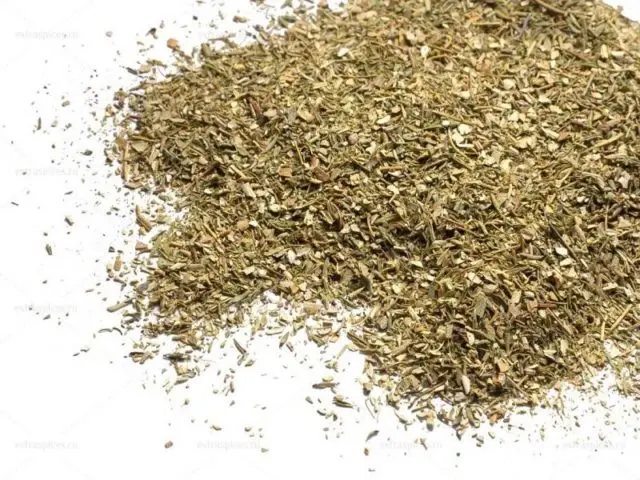
Where is savory added
Spicy grass has found its application in cooking, the alcoholic beverage industry, and perfumery. On its basis, invigorating drinks are created, where yarrow and thyme are added. Such a product has, in addition to tonic properties, also a therapeutic – hemostatic effect. Savory is added to the famous Bulgarian ketchup.
For dressing salads, it is recommended to prepare an infusion of spices in vegetable oil. The blank is suitable for any salad, to which it gives a spicy flavor.
Added to dishes, savory herb leaves allow it to be preserved longer due to the effect of disinfection. Experts recommend putting the spice in soups and other first courses at the very end of cooking, and frying food at the beginning of cooking.
It is believed that spicy savory grass planted next to legumes repels pests that threaten the crop, and the substances that make up the green mass help in the fight against black leg.
Research is being conducted to accelerate seed germination after treatment with essential oils derived from the spice plant.
The use of savory in cosmetology
The essential oil obtained from the spice is a good remedy for alopecia. It is able to cook hair, strengthen the bulbs. Doctors recommend preparations based on savory for skin problems – dermatitis, furunculosis, acne.
The cosmetic industry produces various forms and types of products with savory in the composition:
- massage oils;
- bath foam;
- shower gel;
- Kremov;
- air fragrances.
Conclusion
Savory is a plant long and well known to mankind. Spicy grass is successfully used in many areas of life – medicine, cooking, cosmetology, agriculture, landscape design. If the measure is followed and used correctly, dishes with seasoning acquire a brighter taste, the treatment of many diseases is more successful, the garden plot looks more beautiful and comfortable. These factors are a good reason for the spice culture to find its place in the garden plot.









